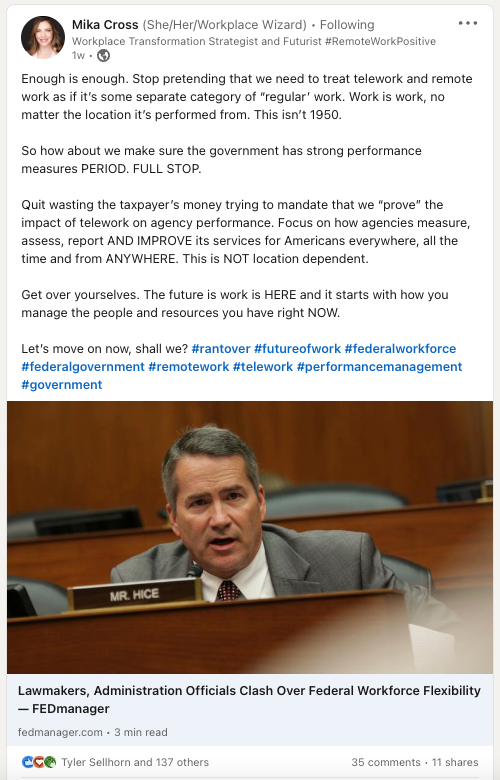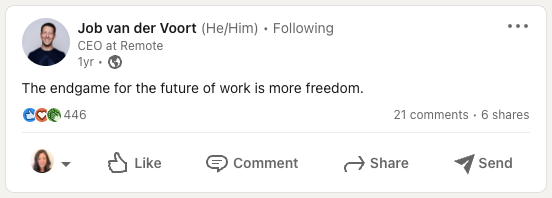Produce8
MSPs looking for the Produce8 Playbook, look no further!
3 Experts Discuss the Future of Remote Work and Whether or Not The Office Is Going Extinct
“I'm not going to pine for the office. I'm not going to think about how it could have been different or how we should try to do things the way we used to in the office. I’m committed to creating a world-class remote organization.”
Those were the words Shauna Moran, Founder and Managing Director of Operate Remote , heard when she first met one of her clients. He was the CEO of his company and he came to her with an open mind and a high level of adaptability intelligence.
After his team began working from home in March 2020 to accommodate pandemic mandates, he made this decision. And the business remained remote, she said.
Moran provides coaching and training to hybrid and remote teams to help them increase their productivity and engagement while reducing burnout. And as she worked with this particular CEO and his team, she says she saw their business thrive as they embraced remote-first.
Aside from supporting what the team wanted and seeing improvements in productivity, the company was also able to reinvest dollars previously associated with renting a physical office space into new areas, including continuing to strengthen its remote teamwork model.
So while other businesses were ‘waiting it out’ for things to return to the way they used to be, this business never looked back. And after thriving for two years, the company was purchased and the team began building its next remote-first startup.
In Moran’s experience, companies like this that continue to improve their remote infrastructure and continue to invest in their teams in a distributed way are rewarded.
“They see the benefits of having more access to talent—talent that wants flexibility. And they also see the benefits of having an amazing culture where people are retained.”
Remote work is no longer just a ‘perk’
“Remote is always going to be a part of all of our lives now in some way, shape or form,” said Moran.
There's always going to be a need for that level of flexibility. If you're making people come back into the office and they don't want to, you're probably not going to retain those people, she said.
“It's not just a way of working anymore, it's a way of living your life.”

During the pandemic, people were introduced to the remote-first work model. It allowed them to cut the commute out of their workdays, spend more time with their families and have more time to do the things they love. Now they don’t want to give that up, she said.
“Companies have to actually listen to what their team members want. They might want a little bit more in-person collaboration, but the general consensus is, ‘we want flexibility above everything else.”
And the data supports this.
According to a 2021 survey by job search site FlexJobs, 58% of respondents desired full-time remote work and 39% wanted a hybrid work situation. That means 97% of survey respondents were looking for some form of remote work flexibility.
Another survey by McKinsey found 87% of people who were given the opportunity to work remotely were taking their employers up on it. And previous research by the consulting firm found workplace flexibility was a leading reason why workers accepted new job offers early in the pandemic.
“Employers should be aware that when a candidate is deciding between job offers with similar compensation, the opportunity to work flexibly can become the deciding factor.”
So if people want more remote work flexibility and businesses are starting to listen, what happens to the office?
The changing face of office space
Office vacancy rates rose significantly during the third quarter of 2021 reaching a peak of 17.2% , according to an article in the Wharton School business journal.
“As tenants start to rethink space needs and their leases rollover, they’ll go into better buildings, and the [worse] buildings will be in trouble,” said Wharton real estate professor Joseph Gyourko in a podcast for the publication.
For some businesses, it’s not about moving into a better office space or even a smaller office space, it’s about saying goodbye to the office space all together.
“There will be huge variation, but I think people and families want the flexibility of at least a day [at home], and I think bosses are going to have to give it whether they like it or not…I don’t think we’ll go back to pre-COVID. I just don’t,” he said.
As a workplace transformation strategist and futurist, Mika Cross is already seeing the beginnings of this process.

Cross works with businesses, government agencies, and organizations of all shapes and sizes to help them put the right workforce training, policies and programs in place. She also coaches on change management strategy and works to help her clients embrace the future of work.
Cross said a lot of organizations that ended up seeing success and even flourishing during the height of the pandemic and work-from-home are now taking some thoughtful time to consider their strategies going forward.
“And let’s be honest, many employers who invested or are investing a lot of money in a physical office space and location have a vested interest in trying to figure out what in the world they're going to do with that space.”
Adding remote work to the federal agenda
Cross currently serves as a strategic advisor for the U.S. federal government—an industry in which moving away from office space could have broad implications, not just for its workforce but also for the nation at large.
“In 2020 there was a Senate hearing on the reduction of office space and what could be done based on federal telework trends,” she said.
The goal was to modernize federal telework using lessons learned during the pandemic. And according to Senator James Lankford, before that it had “been a decade since the last significant piece of telework legislation, the Telework Enhancement Act of 2010.”
At the time, this set the baseline standards in terms of federal telework.
Witnesses at the 2020 hearing spoke about the benefits of remote work in terms of recruitment, retention and cost savings after the pandemic ends. And since then, some are urging congress to pass the Telework Metrics and Cost Savings Act .
“It’s estimated by Global Workforce Analytics that taxpayers could save close to $2 billion annually in real estate costs alone and an additional $11 billion in cost savings on things like productivity, absenteeism, presenteeism, utility cost, commuting and environmental impacts,” said Cross.
Nearly 60% of the federal workforce in the U.S. were working remotely every day, all day during the height of the pandemic, she said.
“It'll be interesting to see if they try to push things back to the way that they were operating beforehand.”

The business case for embracing remote work
Of course, it’s not just the public sector workforce that benefits from a remote-first approach to work. Further data from Global Workforce Analytics states an average employer can save $11k per half-time remote worker per year.
You can try GWA’s telework workplace savings calculator if you want to explore the potential ROI for your business.
Numbers like these are certainly enough to sway some business leaders. In Cross’ experience though, if certain people in an organization are convinced that continuing with remote work won't work then it doesn't matter what data, ROI calculations or justifications you put in front of them.
“The data is important. ROI is important. Cost savings are important. But at the end of the day, people have biases,” said Cross. “We have to pick away at proximity bias, location bias, distance bias and the mindset bias that breeds resistance very carefully, very politically so we can try to get to a more flexible mindset where we can embrace change and possibility—especially in this environment.”
Because what you do today will certainly affect your future, she said.
“I think it comes down to a holistic approach. If you're an employer, you need to really take time to listen to the employee experience and consider generational differences and what's going on in the world of work for your independent workers as well."
"It really does depend on peeling back the data a little bit further to offer a variety of flexible work options that suit the nature of the position and offer choices for workers that want very different ways of working in the new, new normal.”
Remote work isn’t eliminating the office anytime soon
So the office isn’t actually going extinct. Not yet, anyways.
There are still a lot of people and companies that aren’t ready to make this physical or mental shift for the long haul. And of course, this conversation leaves out a lot of industries and professions that will simply never be able to go entirely remote simply due to the nature of the work.
“Offices are necessary for many reasons. It is nice to come together and work in person occasionally, and for certain types of work it is absolutely necessary,” said Job van der Voort CEO and co-founder of Remote —a platform that helps companies onboard and pay remote employees from anywhere in the world.

“It’s also the case that not everyone can work from home.”
An office is a place where people do work, and they’re often well-designed with ergonomic work stations and facilities that contribute to worker efficiency and effectiveness, he said.
“They create a separate space outside of your day-to-day life. So if you don’t have the luxury to have a home office, an office is a great solution for that,” he said. “The problem comes when you’re forced to go to one and you’re expected at certain times.”
Before his current role, van der Voort worked for GitLab and experienced first-hand the seamlessness of working on a distributed team.
“We never had an office and it worked incredibly well. It always seemed ridiculous to me that you had to go through an office if all your work was behind a computer,” he said.
And beyond just making remote work functional, during his time with GitLab van der Voort saw how a company could scale and even IPO while fully remote. The benefits were clear, but he did notice one problem: hiring people in different countries was challenging. He decided to solve this.
Supporting the remote-first work model for people all around the world is something his business now does. But it wasn’t the driving force behind it.
“The real underlying reason [Remote was founded] is not because I think working remotely is so important, but rather I think it’s very important that it shouldn’t matter where on the planet you live, you should have access to great opportunities that pay well.”
Location shouldn’t dictate pay rate, he reasoned. If people have comparable skills, they should be able to earn a comparable income. But that so often isn’t the case. Remote work capability makes this possible, opening up all kinds of opportunities for employers and workers alike.

The consequences of resisting remote flexibility
The work landscape is undoubtedly changing, and hesitant business leaders need to at least be open to exploring new possibilities for the future of work .
So what’s in store for the businesses that continue to resist?
“I’m sure they will see some sort of minor exodus if not major exodus of talent at their companies. They’ll face the consequences and have to relearn,” said van der Voort.
The evidence is out there that remote-first works really well and it makes people happier and therefore more productive, he said.
“Talk to companies that do work remotely and see how they perform,” he suggests.
Afterall, what more can a company want than to have a team of happy, productive people? And whether that’s achieved through remote, hybrid or even office-based work, that should be the end goal as we look ahead to the future of work.
“I think the future of the office is that we go to more of a flexible workspace—think more co-working space, less of a traditional office style,” said van der Voort. “I think that is where we’re headed.”
Related Aritcles
Digital Work Analytics reporting
AIRO Part 4 - From Reactive IT to Managed AI - The Next Evolution for MSPs
2 min read
Unlock great workdays
Wether you are collaborating with your team or solo tackling your day we can help you recover the most valuable asset, time.
